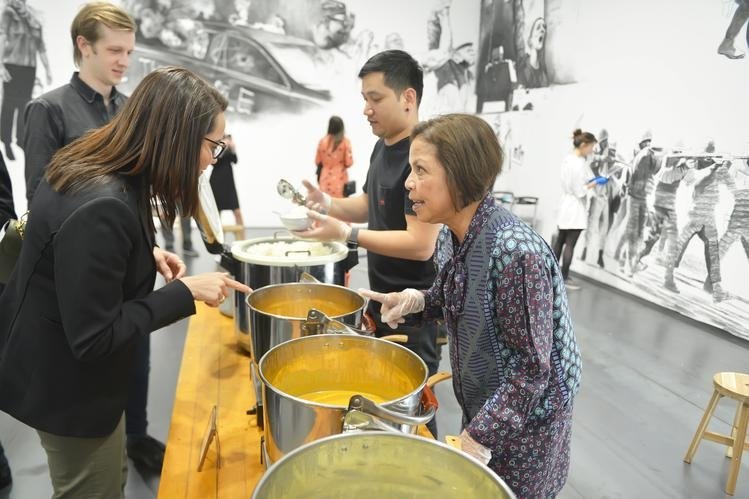REVIEW: Rirkrit Tiravanija at Wrightwood 659
Installation view of Rirkrit Tiravanija: (who’s afraid of red, yellow, and green), Hirshhorn Museum and Sculpture Garden, 2019. Photo by Shannon Finney. Courtesy Hirshhorn Museum and Sculpture Garden.
REVIEW
Rirkrit Tiravanija: (who's afraid of red, yellow, and green)
May 15 - July 16, 2022
Wrightwood 659
659 W. Wrightwood
Chicago, IL 60614
By Alexandria Knapik
Wrightwood 659 is the host of Rirkrit Tiravanija: (who's afraid of red, yellow, and green), a culinary and civic-uprising-themed exhibition. Walking into Wrightwood 659 is a treat in and of itself, the architecture of the Tadao Andō building is incredibly conducive with their socially relevant exhibitions, enhanced by the textures in the walls, flooring, ceiling, and details which are usually uncommon in contemporary art galleries. The exhibition is on the first floor, I went with some friends on the first day it was open.
Upon arrival guests are invited to have a bowl of red, green, or yellow curry and have the option to add additional spices too. There happened to be three of us when I visited, and we tried one of each so I can confidently confirm they are all delicious. The green and yellow were my favorites, but it’s worth trying all of them. Seconds are allowed and there is a water station on the other side of the gallery. There are flat short wooden stools scattered around the gallery, attendees used them as chairs or tables, though we were informed they were meant to be chairs. It was when we sat down after being served by the lovely attendants that the exhibition hit us.
We noticed artists scattered drawing snippets of civil unrest and international moments in history of governments clashing with citizens on the walls while we ate. I was content to see one of the first complete drawings was a sign that read “Fred Hampton Another Police Murder.” I’m a sucker for the local relevance, especially given the international themes of the exhibition, the artist, the food, and the rest of the art being created around us. The colors red, green, and yellow also refer to the colors of the political groups in Thailand, where the artist resides.
The question of fear is directly asking viewers to consider their response to symbolism in political colors. Personally, red and blue make me feel some type of way too. Initially, it felt kind of like life has for the past few years, either participating in protests or participating in collective care. Then, it really set in as people around the gallery spoke to each other and the history of the exhibition lay plainly out, in a way similar to modern use of phrases from older languages. The act of gathering, talking, and eating while the drawings unfolded and developed is a performance piece on the way movements develop. Someone could be talking a about a piece and subject while the narrative itself is changing. Everyone’s visit is also guaranteed to be different because the art is evolving. If I were to visit on the last day of the exhibition, I probably wouldn’t recognize it anymore. It is very impactful even to those who didn’t do their “homework” and read up on the context of the artist, Thailand politics, and international curry flavors, but it never hurts.
Like what you’re reading? Consider donating a few dollars to our writer’s fund and help us keep publishing every Monday.


